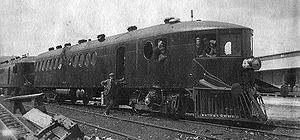- McKeen railmotor
-
The McKeen Railmotor was a 6 cylinder petrol engine with a passenger capacity of 73. When McKeen Company of Omaha, Nebraska, U.S.A. first unveiled the car in 1915, the McKeen was among the first engines with a gasoline-powered motor.[1] Revisions to the McKeen car led to the modern self-propelled gasoline rail-motor vehicle, and the "contours of the porthole windows, the front-mounted gasoline engines, and other features anticipated the streamline concept."[2]
Contents
Background
William R. McKeen was the superintendent of motive power and machinery at Union Pacific Railroad in 1904 when Edward H. Harriman, the head of UP, began encouraging him to develop the machine. The results of his experiments that year was a "knife-nosed" or "windsplitter" unit with a distinctive pointed nose, rounded end, center-entry doors and porthole windows that slightly resembled a submarine on wheels. Two lengths, 55 and 70 feet, were offered; either could be fitted out with a large mail and express area ahead of the center doors, a smaller mail/express area, or the car could be all seats for a maximum capacity of 64 or 105 respectively. Cheaper and more powerful than battery-powered vehicles, the McKeen was more flexible than steam locomotives and could operate at competitive speeds.[3]
Usage
The McKeen was popular from 1915 through the 1930s throughout the United States, and the cars were featured on the Union Pacific and the Southern Pacific.
Two McKeen railmotors were purchased and delivered to the Victorian Railways in Victoria, Australia in 1911. They served throughout their life as a railmotor they ran the Ballarat to Maryborough and Hamilton to Warrnambool services. The railmotors had a poor record with many breakdowns, they only lasted around 3 years as railmotors. In 1919 they were de-engined and converted to passenger cars numbered as ABCL 1 & 2 for use on the Altona line until they were scrapped in August 1926.
In June, 1911, Queensland Railways ordered five self-propelled rail cars from the McKeen Motor Co of Omaha, Nebraska, USA, at a cost of £4500 per unit. They were delivered in May, 1913. Originally seating capacity was 75; this was later reduced to 69, 55 in the main section and 14 in the "smoker". Although popular on the United States Union Pacific and Southern Railroads, the McKeen Cars failed to meet QR's expectations. All five units were written off between 1929 and 1931 and broken up soon after at the Ipswich workshops.[4][5]
Legacy
The Nevada State Railroad Museum completed the of restoration McKeen car, #22 of the Virginia and Truckee Railroad, a 70 foot car by 05/09/2010. The original powerplant did not survive, but it is planned to replace it with a modern engine and drive system to allow the car to transport visitors to the museum around its short track.
See also
References
- ^ O'Connell, J. (1954) Railroad Album: The Story of American Railroads in Words and Pictures. Popular Mechanics Press. p 79.
- ^ Klein (1989) p 298 as cited in Grant, H.R. (2005) The Railroad: The Life Story of a Technology. Greenwood Press. p 83.
- ^ Grant, H.R. (2005) The Railroad: The Life Story of a Technology. Greenwood Press. p 83.
- ^ Stubbs, G. (2006) "QR'S Unusual McKeen Cars," Commissioner's Notebook. 3(35). 27 August 2006.
- ^ The McKeen Cars of Queensland Knowles, John Australian Railway Historical Society Bulletin, October, 2002 pp363-371
External links
- McKeen Rail Motor Cars Operating Manual from Victorian Railways
- Historic photo
Locomotives and rollingstock of the Victorian Railways and successors Steam 'Old' A Class · 'New' A Class · AA Class · A2 Class · B Class · C Class · D Class · Dd Class · E Class · F Class · H Class · J Class · K Class · L Class · M Class · N Class · O Class · P Class · Q Class · 'Old' R Class · 'New' R Class · R Class · S Class · T Class · U Class · 'Old' V Class · V Class · W Class · X Class · Y Class · Z Class · Crane locomotivesDiesel-Electric Diesel-Hydraulic M class · V class · W classElectric Road Transferrable Locomotives RTL ClassCarriages Fixed wheel carriages · A/AA type carriages · AA/A type carriages · BG type carriages · E type carriages · H type carriages · K type carriages · N type carriages · PL type cars · S type carriages · V type carriages · W type carriages · Z type carriages · Royal Trains · Dining & Buffet cars · Sleeping cars · Joint and shared stock (SAR) · Joint and shared stock (NSWGR)Railmotors McKeen · Kerr Stuart · AEC · Leyland · DERM · 102hp Walker · 153hp Walker · 280hp Walker · DRC railcar · Sprinter DMU · VLocity DMU · Trailer carsSuburban electric Freight vehicles Car Transport · Box & Louvre vans · Flat Wagons · Hopper wagons · Livestock · Open wagons · Tank wagonsVans 2 ft 6 in (762 mm) Narrow Gauge Other Categories:- Victorian Railways railmotors
- Rail transportation in Nebraska
Wikimedia Foundation. 2010.


